Base Flow Separation
Methods of Base Flow Separation
The surface-flow hydrograph is obtained from the total storm hydrograph by separating the quick-response flow from the slow response runoff. It is usual to consider the interflow as a part of the surface flow in view of its quick response. Thus only the base flow is to be deducted from the total storm hydrograph to obtain the surface flow hydrograph. There are three methods of base-flow separation that are in common use.
Method 1
In this method the separation of the base flow is achieved by joining with a straight line the beginning of the surface runoff to a point on the recession limb representing the end of the direct runoff.
In Fig..1, pointA represents the beginning ofthe direct runoff off and it is usually easy to identify in view of the sharp change in the runoff rate at that point. Point B, marking the end of the direct runoff is rather difficult to locate exactly.

Fig..1. Method 1 for base flow separation.
An empirical equation for the time interval N (days) from the peak to the point B is
 (23.1)
(23.1)
WhereA is drainage area in km2and N is in days. Points A and B are joined by a straight line to demarcate to the base flow and surface runoff. This method of base-flow separation is the simplest of all the three methods.
Method 2
In this method the base flow curve existing prior to the commencement of the surface runoff is extended till it intersects the ordinate drawn at the peak (point C in Fig. 23.2). This point is joined to point B by a straight line. Segment AC and CB demarcate the base flow and surface runoff. This is probably the most widely used base-flow separation procedure.

Fig. 2. Method 2 for base flow separation.
Method 3
In this method the base flow recession curve after the depletion of the flood water is extended backwards till it intersects the ordinate at the point of inflection (line EF in Fig. 23.3). Points A and F are joined by an arbitrary smooth curve. This method of base-flow separation is realistic in situations where the groundwater contributions are significant and reach the stream quickly.

Fig. 3. Method 3 for base flow separation.
The surface runoff hydrograph obtained after the base-flow separation is also known as direct runoff hydrograph (DRH).
Example 1
The following are the ordinates of the hydrograph of flow from a catchment area of 770 km2 due to a 6-h rainfall. Derive the ordinates of DRH. Make suitable assumptions regarding the base flow.
|
Time from beginning of storm |
(h) |
0 |
6 |
12 |
18 |
24 |
30 |
36 |
|
Discharge |
(m3/s) |
42 |
65 |
215 |
360 |
400 |
350 |
270 |
|
Time from beginning of storm |
(h) |
42 |
48 |
54 |
60 |
66 |
72 |
|
|
Discharge |
(m3/s) |
205 |
145 |
100 |
70 |
50 |
42 |
Answer:
Given: catchment area (A) = 770 km2
Using equation 23.1,


From given data, with our convenience, base flow = 42 m3/s at 72 h
Therefore, DRH = Flood Hydrograph – Base flow
|
Time from beginning of storm |
Discharge |
Base flow |
DRH |
|
h |
m3/s |
m3/s |
m3/s |
|
0 |
40 |
42 |
-2 |
|
6 |
65 |
42 |
23 |
|
12 |
215 |
42 |
173 |
|
18 |
360 |
42 |
318 |
|
24 |
400 |
42 |
358 |
|
30 |
350 |
42 |
308 |
|
36 |
270 |
42 |
228 |
|
42 |
205 |
42 |
163 |
|
48 |
145 |
42 |
103 |
|
54 |
100 |
42 |
58 |
|
60 |
70 |
42 |
28 |
|
66 |
50 |
42 |
8 |
|
72 |
42 |
42 |
0 |
Example 2
The daily stream flow data at a site having a drainage area of 6500 km2 are given in the following table. Separate the base flow using the above three methods.
|
Time (days) |
Discharge (m3/s) |
|
1 |
1600 |
|
2 |
1550 |
|
3 |
5000 |
|
4 |
11300 |
|
5 |
8600 |
|
6 |
6500 |
|
7 |
5000 |
|
8 |
3800 |
|
9 |
2800 |
|
10 |
2200 |
|
11 |
1850 |
|
12 |
1600 |
|
13 |
1330 |
|
14 |
1300 |
|
15 |
1280 |
Answer
1. Plot the total runoff hydrographMethod 1: join point A, the beginning of direct runoff, to point B, the end of direct runoff. Both points are selected by judgment.
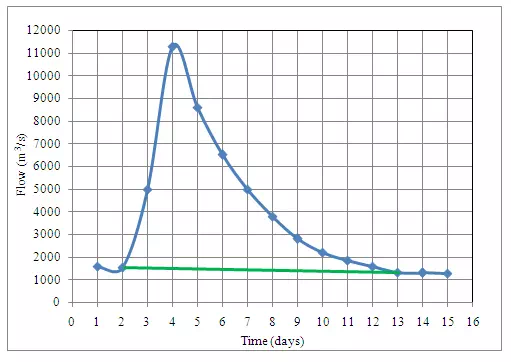
2. Method 2: Extend the recession curve before the storm up to point C below the peak. Join point C to D, computed using equation

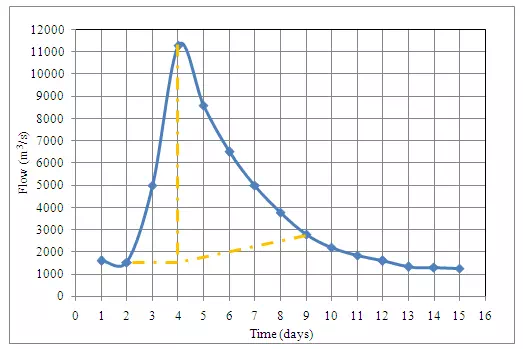
3. Method 3: Extend the recession curve backward to point E. Join point E to A
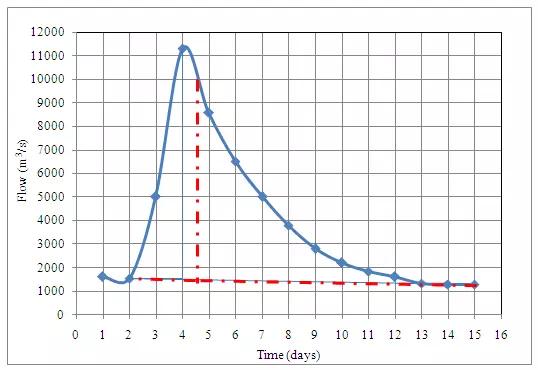
4. The ordinates DRH by three methods are given in Table
Table Ordinates of DRH by different methods
|
Time |
Total runoff |
Base flow |
Direct runoff |
||||
|
Method 1 |
Method 2 |
Method 3 |
Method 1 |
Method 2 |
Method 3 |
||
|
(days) |
(m3/s) |
(m3/s) |
(m3/s) |
(m3/s) |
(m3/s) |
(m3/s) |
(m3/s) |
|
1 |
1600 |
1600 |
1600 |
1600 |
0 |
0 |
0 |
|
2 |
1550 |
1550 |
1550 |
1550 |
0 |
0 |
0 |
|
3 |
5000 |
1520 |
1480 |
1500 |
3480 |
3520 |
3500 |
|
4 |
11300 |
1500 |
1400 |
1450 |
9800 |
9900 |
9850 |
|
5 |
8600 |
1450 |
1700 |
1400 |
7150 |
6900 |
7200 |
|
6 |
6500 |
1450 |
1950 |
1400 |
5050 |
4550 |
5100 |
|
7 |
5000 |
1450 |
2300 |
1400 |
3550 |
2700 |
3600 |
|
8 |
3800 |
1400 |
2550 |
1400 |
2400 |
1250 |
2400 |
|
9 |
2800 |
1380 |
2800 |
1380 |
1420 |
0 |
1420 |
|
10 |
2200 |
1380 |
2200 |
1380 |
820 |
0 |
820 |
|
11 |
1850 |
1380 |
1850 |
1380 |
470 |
0 |
470 |
|
12 |
1600 |
1350 |
1600 |
1350 |
250 |
0 |
250 |
|
13 |
1330 |
1330 |
1330 |
1330 |
0 |
0 |
0 |
|
14 |
1300 |
1300 |
1300 |
1300 |
0 |
0 |
0 |
|
15 |
1280 |
1280 |
1280 |
1280 |
0 |
0 |
0 |

Effective Rainfall Hyetograph
Effective rainfall (also known as Excess rainfall) (ER) is that part of the rainfall that becomes direct runoff at the outlet of the watershed. It is thus the total rainfall in a given duration from which abstractions such as infiltration and initial losses are subtracted. For purposes of correlating DRH with the rainfall which produced the flow, the hyetograph of the rainfall is also pruned by deducting the losses. Figure 23.4 shows the hyetograph of a storm. The initial loss and infiltration losses are subtracted from it. The resulting hyetograph is known as effective rainfall hyetograph (ERH). It is also known as excess rainfall hyetograph.

Fig.4.Effective rainfall hyetograph.
Both DRH and ERH represent the same total quantity but in different units. Since ERH is usually in cm/h plotted agains1 time, the area of ERH multiplied by the catchment area gives the total volume of direct runoff which is the same as the area of DRH. Theinitial loss and infiltration losses are estimated based on the available data of the catchment.
Example 3
A 4-hour storm occurs over an 80 km2 watershed. The details of the catchment are as follows:
|
Sub Area |
Φ index |
Hourly rain (mm) |
|||
|
km2 |
mm/h |
1st hour |
2nd hour |
3rd hour |
4th hour |
|
15 |
10 |
16 |
48 |
22 |
10 |
|
25 |
15 |
16 |
42 |
20 |
8 |
|
35 |
21 |
12 |
40 |
18 |
6 |
|
5 |
16 |
15 |
42 |
18 |
8 |
Calculate the runoff from catchment and the hourly distribution of the effective rainfall whole catchment.
Answer:
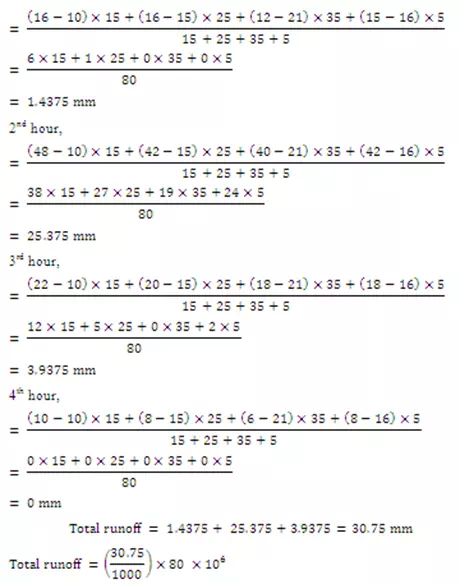
Totalrunoff = 2.46Mm3
Hourly distribution of the effective rainfall for the whole catchment:
|
|
Effective rainfall (mm) |
|
1st hour |
1.4375 |
|
2nd hour |
25.375 |
|
3rd hour |
0 |
|
4th hour |
3.9375 |
Example 4
A storm in a certain catchment had three successive 6-h intervals of rainfall magnitude of 3.0 cm, 5.0 cm and 4.0 cm, respectively. The flood hydrograph at the outlet of the catchment resulting from this storm is as follows:
|
Time |
(h) |
0 |
6 |
12 |
18 |
24 |
30 |
36 |
42 |
|
Flood hydrograph ordinates |
(m3/s) |
30 |
480 |
2060 |
4450 |
6010 |
6010 |
5080 |
3996 |
|
Time |
(h) |
48 |
54 |
60 |
66 |
72 |
78 |
||
|
Flood hydrograph ordinates |
(m3/s) |
2866 |
1866 |
1060 |
500 |
170 |
30 |
If the area of the catchment is 8791.2 km2, estimate the index of the storm. Assume the base flow as 30 m3/s.
Answer
Flood hydrograph ordinates = DRH ordinates +Base flow ordinates
Direct runoff(cm) = 
Where
is direct runoff ordinates (m3/s), is time interval between successive ordinates (h), A is catchment area (km2)
|
Time |
Flood hydrograph Ordinates |
Base flow |
DRO |
|
H |
m3/s |
m3/s |
m3/s |
|
0 |
30 |
30 |
0 |
|
6 |
480 |
30 |
450 |
|
12 |
2060 |
30 |
2030 |
|
18 |
4450 |
30 |
4420 |
|
24 |
6010 |
30 |
5980 |
|
30 |
6010 |
30 |
5980 |
|
36 |
5080 |
30 |
5050 |
|
42 |
3996 |
30 |
3966 |
|
48 |
2866 |
30 |
2836 |
|
54 |
1866 |
30 |
1836 |
|
60 |
1060 |
30 |
1030 |
|
66 |
500 |
30 |
470 |
|
72 |
170 |
30 |
140 |
|
78 |
30 |
30 |
0 |
|
= 34188 |
|||
Therefore,
Direct runoff (cm) = 
Directrunoff (cm) = 8.4
Therefore

φ = 0.2cm/h
|
Rainfall (cm) |
3 |
5 |
4 |
|
Time interval (h) |
6 |
6 |
6 |
|
Rainfall intensity (cm/h) |
0.5 |
0.833 |
0.667 |
|
index (cm/h) |
0.2 |
0.2 |
0.2 |
|
Excess rainfall intensity |
0.3 |
0.633 |
0.467 |
Elemental Hydrograph
If a small, impervious area is subjected to a constant rate rainfall, the resulting runoff hydrograph will appear much as above, and is known as elemental hydrograph (Fig. 23.5). In the beginning, there will be surface detention (rainfall-runoff) so as to start the sheet flow over the surface. At point B, known as point of equilibrium, outflow rate equals inflow rate. When rainfall ends (at C), recession starts, i.e., outflow rate and detention volume increases.
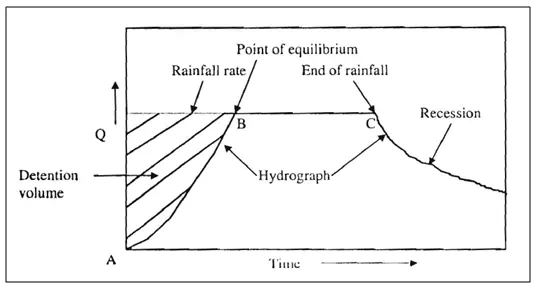
Fig. 5.Elemental hydrograph.